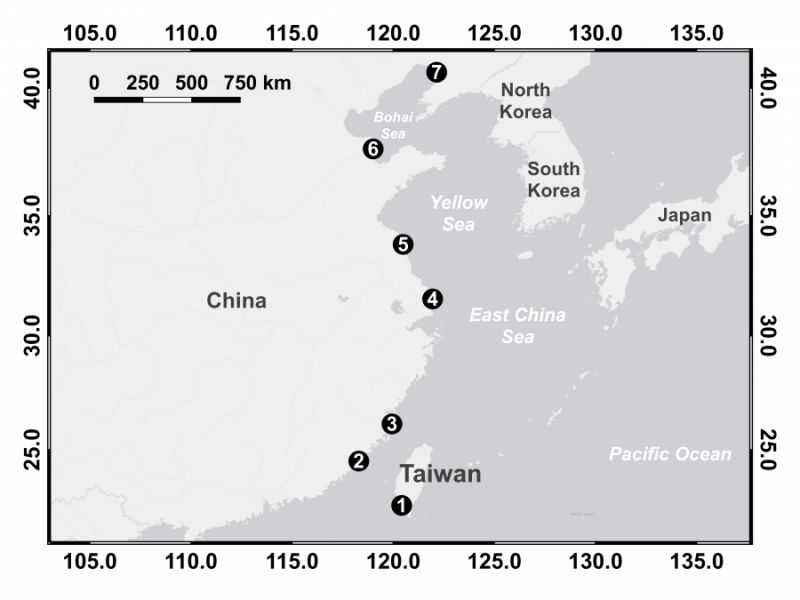生態農業:農業溫室氣體減量【生命科學系/林幸助特聘教授】
| 論文篇名 | 英文:Contribution of unvegetated tidal flats to coastal carbon flux 中文:光灘對沿岸碳通量之貢獻 |
| 期刊名稱 | GLOBAL CHANGE BIOLOGY |
| 發表年份,卷數,起迄頁數 | 2020, 26 (6): 3443-3454 |
| 作者 | Lin, Wei-Jen; Wu, Jihua; Lin, Hsing-Juh(林幸助)* |
| DOI | 10.1111/gcb.15107 |
| 中文摘要 | 沒有植被生長的潮間帶灘地廣泛分佈於沿海潮間帶地區,儘管潮間帶灘地受到人為開發及氣候變遷的威脅日益劇增,但是和植被生長的藍碳生態系相比,潮間帶灘地的碳匯量則很少被量化。本研究分別於2012年至2016年間的夏、冬季測量位於東亞緯度梯度(22.48°N ~ 40.60°N)上7處潮間帶灘地最大總生產量(maximum gross primary production, GPPm)、總呼吸量(total respiration, TR)及淨生產量(net primary production, NCP),評估潮間帶灘地碳通量在緯度梯度間的時空變化。結果顯示,冬季期間GPPm、TR及NPP往高緯度地區下降89% ~ 104%,然而,在夏季期間GPPm、TR及NPP則沒有明顯的趨勢變化。底土溫度是潮間帶灘地碳通量在緯度梯度間變化的主要影響因子,GPPm、TR及NPP會隨著底土溫度上升而增加,但超過最適溫度之後,GPPm、TR及NPP則隨著底土溫度上升而減少。GPPm及NPP的最適溫度分別為28.7°C及26.6°C;TR的最適溫度則為49.5°C。緯度梯度間潮間帶灘地最大日淨生產量(maximum daily NPP)平均為0.24 ± 0.28 g C m-2 d-1相當於全球藍碳生態系NPP平均值的10% ~ 20%,當乘上潮間帶灘地全球分佈面積計算後,本研究結果顯示,潮間帶灘地NPP對全球沿海碳循環的貢獻較小,僅有11.04 ± 13.32 Tg C yr-1。但當植被生長的藍碳生態系持續被破壞而退化成潮間帶灘地時,沿海地區的碳匯能力則會減少約13.10 Tg C yr-1,相當於全球碳循環中因土地利用改變所造成碳釋放量的1%。 |
| 英文摘要 | Unvegetated flats occupy a large area in the intertidal zone. However, compared to vegetated areas, the carbon sequestration of unvegetated tidal flats is rarely quantified, even though these areas are highly threatened by human development and climate change. We determined benthic maximum gross primary production (GPPm), net primary production (NPP) and total respiration (TR) during emersion on seven tidal flats along a latitudinal gradient (from 22.48°N to 40.60°N) in winter and summer from 2012 to 2016 to assess the spatial and temporal variability of carbon dioxide flux. In winter, these processes decreased by 89-104% towards higher latitudes. In summer, however, no clear trend was detected across the latitudinal gradient. Quadratic relationships between GPPm, NPP and TR and sediment temperature can be described along the latitudinal gradient. These curves showed maximum values of GPPm and NPP when the sediment temperatures reached 28.7°C and 26.6°C, respectively. TR increased almost linearly from 0 to 45°C. The maximum daily NPP across the latitudinal gradient averaged 0.24±0.28 g C m-2 d-1, which was only 10~20% of the global average of NPP of vegetated coastal habitats. Multiplying with the global area of unvegetated tidal flats, our results suggest that the contribution of NPP on unvegetated tidal flats to the coastal carbon cycle is small (11.04±13.32 Tg C yr-1). If the land cover of vegetated habitats is continuously degraded to unvegetated tidal flats, the carbon sequestration capacity in the intertidal zone is expected to reduce by at least 13.10 Tg C yr-1, equivalent to 1% of global carbon emissions from land-use change. |







